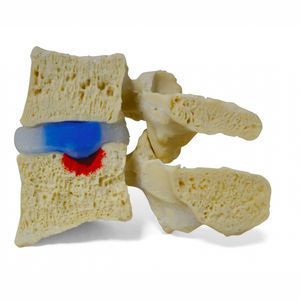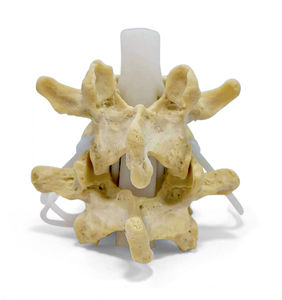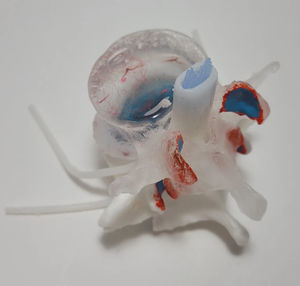
- Primary care
- General practice
- Intervetebral disc model
- Dynamic Disc Designs Corp.
Intervetebral disc model True Blue Professional LxHfor teachingwhiteblue
Add to favorites
Compare this product
Characteristics
- Area of the body
- intervertebral disc
- Procedure
- for teaching
- Color
- white, blue
- Other characteristics
- flexible, transparent
Description
colours designed to help avoid kinesiophobia (if that is a concern)
Features include:
navy blue nucleus pulposus
cauda equina with optional rootlets (red)
intervertebral disc innervation (red) to the outer third of the annulus
circumferential (diffuse) disc bulge
superimposed disc protrusion
limacon shaped annulus
peripherally exposed calcified endplate
elastomeric white articular cartilage
subchondrial bone exposed with a hyaline fibrillation
clear L4 tope and bottom
bone coloured L5
Flexible and dynamic herniating (or prolapse) blue nucleus pulposus. This is achieved through a realistic 2-part intervertebral disc with 6 degrees of freedom. Nuclear migration upon manual compression through a torn annulus fibrosus explaining pain generators under load.
right posterior-lateral radial and circumferential fissure (blue)
nerve ingrowth (neo-innervation) to the inner two-thirds of the damaged annulus to help demonstrate chronic pain (red)
left partial posterior-lateral radial tear matching up to the disc protrusion within a contained nucleus
vasculature in L4 vertebral body (red)
facet subchondrial vascularization (red)
facet tropism (L5 inferior)
Catalogs
No catalogs are available for this product.
See all of Dynamic Disc Designs Corp.‘s catalogsOther Dynamic Disc Designs Corp. products
Lumbar Single Level
Related Searches
- Anatomy model
- Demonstration anatomical model
- Teaching anatomy model
- Surgical anatomical model
- Bone anatomical model
- Flexible anatomical model
- Transparent anatomical model
- Vertebral column model
- Pelvic anatomical model
- Nervous system model
- White anatomical model
- Anatomical model with nerves
- Lumbar vertebral column model
- Cervical model
- Nervous anatomy model
- Intervetebral disc model
- Beige anatomical model
- Gynecological anatomical model
- Puncture anatomy model
- Injection model
*Prices are pre-tax. They exclude delivery charges and customs duties and do not include additional charges for installation or activation options. Prices are indicative only and may vary by country, with changes to the cost of raw materials and exchange rates.










